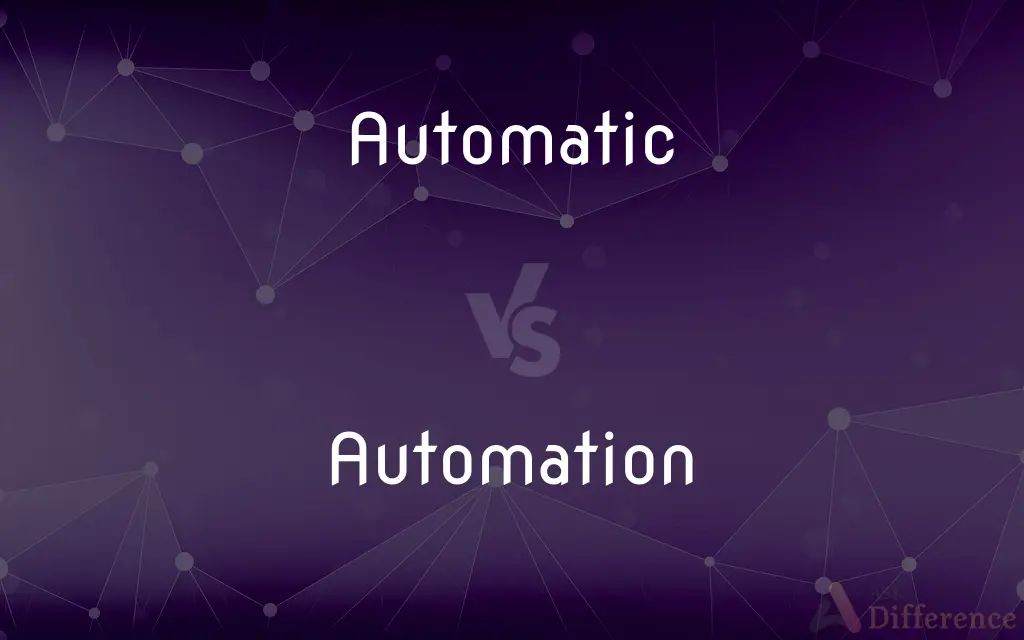Automatic vs. Automation — What's the Difference?
Edited by Tayyaba Rehman — By Fiza Rafique — Updated on April 1, 2024
Automatic processes operate without human intervention once initiated, focusing on efficiency and consistency, whereas automation involves the use of technology to perform tasks, emphasizing the role of machines and systems in streamlining operations.

Difference Between Automatic and Automation
Table of Contents
ADVERTISEMENT
Key Differences
Automatic processes are designed to function independently after they are activated, ensuring operations proceed smoothly and efficiently. This independence is crucial for tasks requiring consistency and minimal variability. On the other hand, automation refers to the broader application of technology to perform tasks, which can range from simple to complex processes. Automation technology not only includes automatic processes but also encompasses the programming and machinery that enable these processes.
Automatic mechanisms are often found in everyday appliances and systems, such as automatic doors that open when they detect motion. These mechanisms are typically straightforward, requiring little to no user input after their initial setup. Whereas automation can be observed in more complex systems like manufacturing assembly lines, where a series of automated processes work together to create a product, demonstrating the scalability of automation solutions.
In the context of benefits, automatic processes offer reliability and efficiency, particularly in tasks that must be repeated with the same parameters. This reliability makes them ideal for applications where the exact repetition of a process is critical. Automation, however, extends these benefits by improving productivity and reducing human error across a wider range of activities, from simple repetitive tasks to complex decision-making processes.
While automatic processes are typically pre-set and have limited flexibility, automation systems are programmable and can be adapted to meet changing requirements. This adaptability of automation allows for customization and reprogramming in response to new tasks or improvements in technology, offering greater flexibility and future-proofing capabilities.
The adoption of automatic processes is often seen as a step towards greater efficiency within a specific task or function. In contrast, the implementation of automation signifies an investment in technology that can transform operations, indicating a strategic approach to innovation and efficiency improvement in businesses or systems.
ADVERTISEMENT
Comparison Chart
Definition
Refers to processes that run independently after initial setup.
Involves the use of technology to perform tasks with minimal human intervention.
Complexity
Typically simple, involving straightforward tasks.
Can range from simple to complex, integrating various technologies.
Flexibility
Limited, operates within predefined parameters.
High, can be reprogrammed or adjusted to new requirements.
Scope
Often limited to specific tasks or functions.
Broad, can be applied to a wide range of operations.
Implementation
Generally involves setting up or activating a mechanism.
Requires programming and integrating technology into processes.
Compare with Definitions
Automatic
Operating by itself with minimal human control.
The automatic coffee maker brews a pot of coffee at the set time every morning.
Automation
The technique, method, or system of operating or controlling a process by highly automatic means.
The company is looking into automation to reduce costs.
Automatic
Acting or done spontaneously or unconsciously.
He gave an automatic nod in response.
Automation
The use of largely automatic equipment in a system of manufacturing or other production processes.
Automation has significantly increased production efficiency in the factory.
Automatic
Involving or relating to reflexes or reflex actions.
Blinking is an automatic response to something flying towards your eyes.
Automation
Technology by which a process or procedure is performed with minimal human assistance.
Home automation allows control of lights and thermostat remotely.
Automatic
Having the capability to start, operate, move, etc., independently.
The car's automatic transmission shifts gears on its own.
Automation
The state of being operated automatically.
With the automation of data entry, employees can focus on more complex tasks.
Automatic
Working by itself with little or no direct human control.
The automatic door opens when someone approaches.
Automation
A method of controlling industrial processes by automatic means.
The plant underwent significant upgrades to include the latest in automation technology.
Automatic
Acting or operating in a manner essentially independent of external influence or control
An automatic light switch.
A budget deficit that triggered automatic spending cuts.
Automation
Automation describes a wide range of technologies that reduce human intervention in processes. Human intervention is reduced by predetermining decision criteria, subprocess relationships, and related actions — and embodying those predeterminations in machines.Automation, includes the use of various control systems for operating equipment such as machinery, processes in factories, boilers, and heat-treating ovens, switching on telephone networks, steering, and stabilization of ships, aircraft, and other applications and vehicles with reduced human intervention.Automation covers applications ranging from a household thermostat controlling a boiler, to a large industrial control system with tens of thousands of input measurements and output control signals.
Automatic
Self-regulating
An automatic washing machine.
Automation
The automatic operation or control of equipment, a process, or a system.
Automatic
Acting or done without volition or conscious control; involuntary
Automatic shrinking of the pupils of the eyes in strong light.
Automation
The techniques and equipment used to achieve automatic operation or control.
Automatic
Acting or done as if by machine; mechanical
An automatic reply to a familiar question.
Automation
The condition of being automatically controlled or operated.
Automatic
Capable of firing continuously until ammunition is exhausted or the trigger is released
An automatic rifle.
Automation
The act or process of converting the controlling of a machine or device to a more automatic system, such as computer or electronic controls.
Automatic
Semiautomatic
An automatic pistol.
Automation
The act of implementing the control of equipment with advanced technology; usually involving electronic hardware;
Automation replaces human workers by machines
Automatic
An automatic machine or device.
Automation
The condition of being automatically operated or controlled;
Automation increases productivity
Automatic
An automatic firearm.
Automation
Equipment used to achieve automatic control or operation;
This factory floor is a showcase for automation and robotic equipment
Automatic
A semiautomatic firearm.
Automatic
A transmission or a motor vehicle with an automatic gear-shifting mechanism.
Automatic
(Football) See audible.
Automatic
Capable of operating without external control or intervention.
The automatic clothes washer was a great labor-saving device.
Automatic
Done out of habit or without conscious thought.
The reaction was automatic: flight!
Absent-minded doodling is a form of automatic art.
Automatic
Necessary, inevitable, prescribed by logic, law, etc.
Spitting at another player means an automatic red card.
Automatic
(of a firearm such as a machine gun) Firing continuously as long as the trigger is pressed until ammunition is exhausted.
Fully automatic weapons cannot be legally owned by private citizens in the US, except in very special circumstances, as by private security companies.
Automatic
(of a handgun) An autoloader; a semi-automatic or self-loading pistol, as opposed to a revolver or other manually actuated handgun, which fires one shot per pull of the trigger; distinct from machine guns.
The US Army adopted John Browning's M1911 pistol as its sidearm, chambered in .45 ACP (Automatic Colt Pistol).
Automatic
Automatically added to and removed from the stack during the course of function calls.
Automatic
Having one or more finite-state automata.
Automatic
A car with automatic transmission.
I never learned to drive a stick. I can only drive an automatic.
Automatic
A semi-automatic pistol.
The G-men raiding the speakeasy were equipped with .45 automatics, while the local policemen were carrying revolvers and shotguns.
Automatic
Having an inherent power of action or motion.
Nothing can be said to be automatic.
Automatic
Pertaining to, or produced by, an automaton; of the nature of an automaton; self-acting or self-regulating under fixed conditions; operating with minimal human intervention; - esp. applied to machinery or devices in which certain things formerly or usually done by hand are done by the machine or device itself; as, the automatic feed of a lathe; automatic gas lighting; an automatic engine or switch; an automatic mouse; an automatic transmission. The opposite of manual.
Automatic
Not voluntary; not depending on the will; mechanical; controlled by the autonomic nervous system; without conscious control; as, automatic movements or functions. The opposite of voluntary.
Unconscious or automatic reasoning.
Automatic
Like the unthinking functioning of a machine.
Automatic
Light machine gun.
Automatic
A pistol that will keep firing until the ammunition is gone or the trigger is released; as, a .45 automatic.
Automatic
Light machine gun
Automatic
A pistol that will keep firing until the ammunition is gone or the trigger is released
Automatic
Operating with minimal human intervention; independent of external control;
Automatic transmission
A budget deficit that caused automatic spending cuts
Automatic
Like the unthinking functioning of a machine;
An automatic `thank you'
Machinelike efficiency
Automatic
Without volition or conscious control;
The automatic shrinking of the pupils of the eye in strong light
A reflex knee jerk
Sneezing is reflexive
Common Curiosities
Why are automatic processes important?
Automatic processes are important for tasks that require consistency, reliability, and efficiency, especially when the same operation needs to be repeated without variations.
What is the main difference between automatic and automation?
Automatic refers to the ability of a process or machine to operate independently once started, while automation involves the use of technology to perform tasks with minimal human intervention.
Is automation more flexible than automatic processes?
Yes, automation systems are generally more flexible because they can be reprogrammed or adjusted according to new requirements.
How does automation impact productivity?
Automation significantly improves productivity by speeding up processes, reducing human error, and allowing human workers to focus on more complex tasks.
What are some common examples of automatic mechanisms?
Examples include automatic doors, thermostats, and lighting systems.
What are some sectors where automation is extensively used?
Manufacturing, automotive, electronics, and healthcare are some sectors where automation is extensively used.
Can an automatic system be considered as automation?
Yes, an automatic system can be a part of automation, but automation encompasses a broader range of technologies and applications.
Can automation be applied in any industry?
Yes, automation can be applied in virtually any industry to improve efficiency, accuracy, and productivity.
How does automation affect employment?
Automation can lead to job displacement in certain sectors but also creates opportunities in areas requiring more complex skills.
Can automation be customized for specific tasks?
Yes, automation systems can be tailored to meet the specific needs of different tasks or processes.
Do automatic processes eliminate the need for human intervention?
While they minimize the need for human intervention, some level of monitoring or setup is often required.
Is it cost-effective to implement automation?
While initial costs can be high, automation can lead to long-term savings and increased efficiency.
How do automatic and automation contribute to quality control?
Both can enhance quality control by ensuring tasks are performed consistently and accurately.
Can automation improve safety in workplaces?
Yes, by handling dangerous tasks or processes, automation can significantly improve workplace safety.
What role does programming play in automation?
Programming is crucial in automation as it allows the customization and control of automated processes.
Share Your Discovery

Previous Comparison
Benzene vs. Propane
Next Comparison
Amenity vs. InfrastructureAuthor Spotlight
Written by
Fiza RafiqueFiza Rafique is a skilled content writer at AskDifference.com, where she meticulously refines and enhances written pieces. Drawing from her vast editorial expertise, Fiza ensures clarity, accuracy, and precision in every article. Passionate about language, she continually seeks to elevate the quality of content for readers worldwide.
Edited by
Tayyaba RehmanTayyaba Rehman is a distinguished writer, currently serving as a primary contributor to askdifference.com. As a researcher in semantics and etymology, Tayyaba's passion for the complexity of languages and their distinctions has found a perfect home on the platform. Tayyaba delves into the intricacies of language, distinguishing between commonly confused words and phrases, thereby providing clarity for readers worldwide.
















































